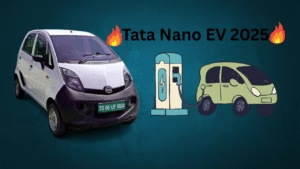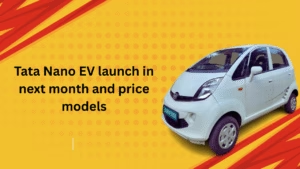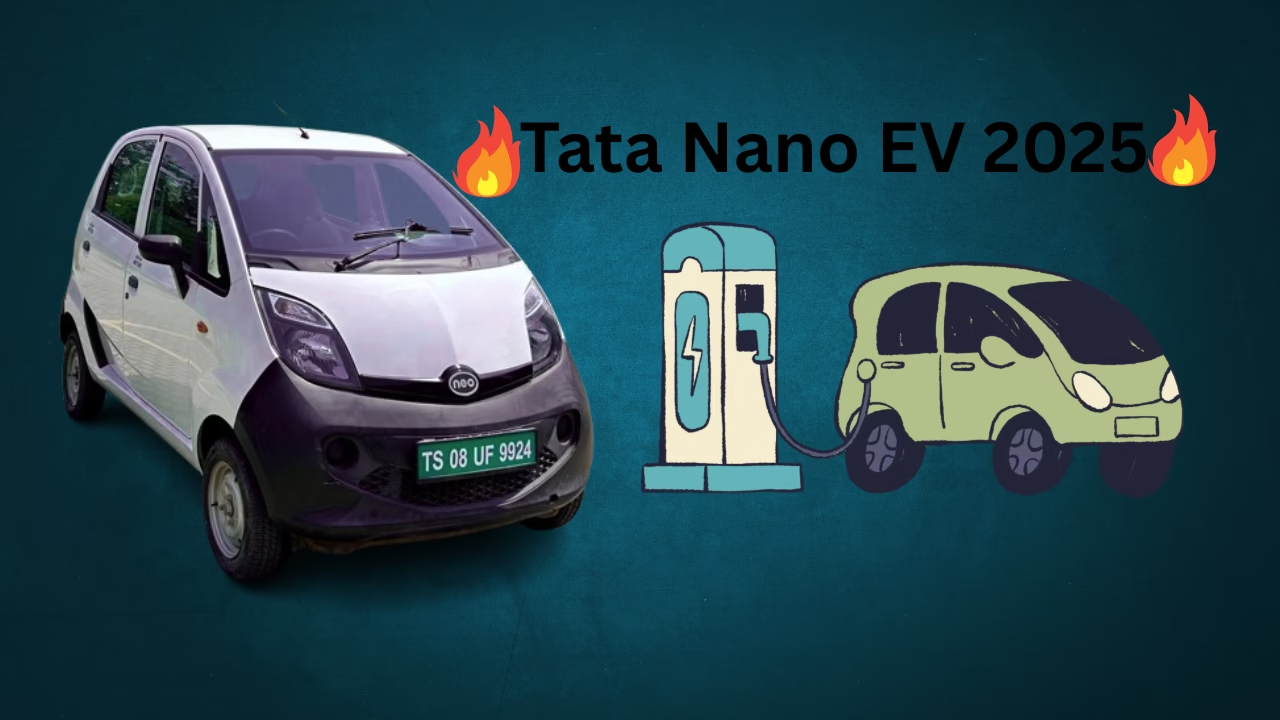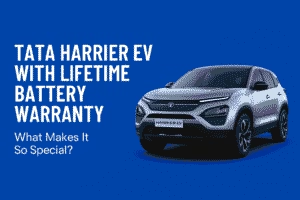The Tata Nano one of the most favourite Indian’s car in automobile industry, once hailed as the world’s cheapest car, is poised to make a successful return as an electric vehicle (EV) in 2025. With its compact design, eco-friendly powertrain, and wallet-friendly price tag, the Tata Nano EV is set to redefine entry-level urban mobility in India. This electrified version of the iconic Nano promises to deliver an affordable, zero-emission commuting solution for city dwellers, catering to the growing demand for sustainable transportation. Let’s dive into what makes the Tata Nano EV 2025 a potential game-changer in the budget EV segment.

Tata Nano EV: A Compact Electric Marvel
The Tata Nano EV 2025 is designed to retain the compact dimensions that made the original Nano a favorite for navigating crowded city streets. Its modern, sleek aesthetics blend practicality with a special vibe, appealing to young urban commuters and locals. While Tata Motors has yet to reveal official specifications, industry suggests the Nano EV will feature a lithium-ion battery pack, offering a practical range of around 150 km on a single charge—perfect for daily commutes, grocery runs, or short city trips.
Performance-wise, the Nano EV is expected to deliver a modest yet peppy 35 horsepower, ensuring a smooth and effortless driving experience in urban traffic. Features like regenerative braking, which recaptures energy during deceleration, will enhance efficiency, while smartphone connectivity and a digital instrument cluster are likely to add a touch of modernity to this budget-friendly EV. These additions make the Nano EV not just a practical choice but also an exciting one for tech-savvy buyers.
Tata Nano EV Price: Affordable Electric Mobility for All
One of the most anticipated aspects of the Tata Nano EV 2025 is its price. Industry experts estimate the Nano EV will be priced between ₹5-7 lakh (ex-showroom), positioning it as India’s most affordable electric car. This competitive pricing makes it a compelling alternative to entry-level petrol hatchbacks like the Maruti Alto or Hyundai Santro. With low running costs—thanks to cheaper electricity compared to fuel and minimal maintenance needs—the Nano EV is poised to attract cost-conscious buyers looking to embrace sustainable mobility without breaking the bank.
By offering an accessible price point, Tata Motors aims to democratize EV ownership, bringing electric vehicles within reach of a broader audience. This move aligns with India’s push for cleaner transportation and could play a pivotal role in accelerating EV adoption in urban centers.
Tata Nano EV Specifications: Practical and Efficient
The Tata Nano EV 2025 is engineered to be a practical city car with specs tailored for urban commuting. Here’s what we expect based on industry insights:
- Battery and Range: A compact lithium-ion battery pack delivering a range of approximately 150 km, ideal for short daily trips.
- Power Output: Around 35 hp, providing sufficient performance for city driving.
- Drive Layout: Front-wheel-drive (FWD) for stable handling and efficient power delivery.
- Charging Options: A standard AC charger for convenient home charging, with fast-charging capability potentially available as an optional feature.
- Seating and Space: A four-seater configuration with enough room for passengers and easy maneuverability in tight spaces.
- Boot Space: Modest cargo capacity, likely similar to the 378 liters seen in the Jayem Neo EV prototype.
The Nano EV’s compact design and lightweight construction make it a breeze to park and navigate through congested urban roads, while its electric powertrain ensures zero tailpipe emissions, contributing to cleaner air in cities.
Tata Nano EV Models: Options for Every Buyer
To cater to diverse customer needs, the Tata Nano EV 2025 is expected to be offered in multiple variants. The entry-level variant will likely focus on affordability, equipped with essential features such as:
- Air conditioning
- Power steering
- Anti-lock Braking System (ABS)
- Dual front airbags
This no-frills option will appeal to budget-conscious buyers prioritizing cost savings and safety.
The top-end variant, on the other hand, is expected to offer a more premium experience with modern features like:
- A touchscreen infotainment system with smartphone integration
- Connected car technology for remote diagnostics and updates
- Six airbags for enhanced safety
- Alloy wheels for a stylish look
These additions will attract buyers seeking a feature-rich city car without stretching their budget. By offering a range of variants, Tata ensures the Nano EV appeals to everyone, from first-time car buyers to those upgrading to an electric vehicle.
The Tata Nano Jayem Neo EV: A Missed Opportunity
To understand the Nano EV’s potential, it’s worth revisiting the Tata Nano Jayem Neo EV, a project that could have reshaped the Nano’s legacy. Launched in 2015 as a collaboration between Tata Motors and Coimbatore-based Jayem Automotives, the Neo EV was an ambitious attempt to electrify the Nano. Two versions were planned: a 48-volt model for taxi fleets and a more powerful 72-volt model for private buyers. The Neo EV boasted impressive specs for its time, including:
- Battery: 39.4 kWh
- Power: 149.55 bhp
- Charger: 3.3 kW with fast-charging capability
- Boot Space: 378 liters
- Price: Around ₹3 lakh (based on early estimates)
Despite its promise, the Neo EV never made it to mass production, with only a few taxi-spec models sold to private buyers in Goa. The project’s cancellation left many wondering what could have been—a budget EV that might have revitalized the Nano brand. The upcoming Nano EV 2025 seems to draw inspiration from the Neo’s vision, aiming to fulfill its unrealized potential.
Also Checkout :
Tata Harrier EV with Lifetime Battery Warranty: What Makes It So Special?
Tata Nano EV launch date
The Tata Nano 2025 most launch in part of year end. This should game changing EV vehicle in EV industry segment at best prices. Currently the Tata Nano EV is in testing phase at it should launch in short period of the time in EV segment. The price and models should be post on expect launch date and will
be ready for test drive in street of India.
next month and price models
Why the Tata Nano EV 2025 Matters
The Tata Nano EV 2025 arrives at a critical time when India is accelerating its transition to electric mobility. With government incentives, improving charging infrastructure, and growing environmental awareness, the demand for affordable EVs is surging. The Nano EV’s combination of low cost, compact design, and eco-friendly performance positions it as a frontrunner in the entry-level EV market.
Moreover, Tata Motors’ expertise in EVs—evident in models like the Nexon EV and Tigor EV—gives the Nano EV a strong foundation. By leveraging its experience in building reliable electric powertrains, Tata can ensure the Nano EV delivers on both performance and durability.
Conclusion: A New Chapter for the Nano Legacy
The Tata Nano EV 2025 is more than just a revival of an iconic nameplate; it’s a bold step toward making electric mobility accessible to millions. With its affordable price, practical specs, and modern features, the Nano EV is poised to become the go-to choice for urban commuters seeking a cost-effective, eco-friendly ride. While the Jayem Neo EV remains a bittersweet “what-if” in Tata’s history, the Nano EV 2025 has the potential to write a new chapter, proving that good things do come in small, electric packages.
Stay tuned for official updates from EV TATA Motors as the Nano EV 2025 prepares to hit the roads, bringing sustainable driving to the masses!





1 thought on “Tata Nano EV 2025: The cheapest Car in local Mobility in India”